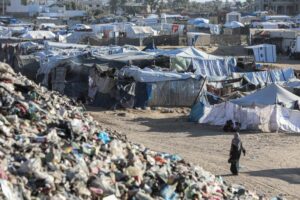Disease and illness are a hidden toll of the Gaza genocide

A view of the area where people live in makeshift tents near trash, garbage piled up in the coastal area of Gaza City, on 24 December 2024
Rifqa Hijazi reports in Mondoweiss on 31 January 2025:
War isn’t just destroyed buildings and displaced populations; it is a humanitarian tragedy that leaves behind long-term physical consequences on individuals and communities.
Repeated Israeli attacks on hospitals and the heavy Israeli restrictions on aid entering Gaza over the past 15 months have left the healthcare sector unable to provide necessary medical care due to a lack of medical and human resources. Many hospitals were destroyed, while others closed due to bombing or shortages of essential supplies. Doctors and nurses faced immense pressure, dealing with overwhelming numbers of patients amid severe shortages of equipment and medications. Israeli forces have subjected medical staff to extreme abuse, killing dozens of doctors and healthcare professionals, and imprisoning and torturing many more.
The war in Gaza has led to the spread of numerous diseases due to devastated infrastructure, environmental pollution, lack of basic health services, overcrowded refugee camps and displacement shelters, and shortages of water and electricity. I myself have experienced how these illnesses are part of the hidden toll of the war, with real, long-term consequences on those affected. While a ceasefire is currently in place, the health situation remains extremely precarious in Gaza, with unsanitary conditions continuing to pose a risk, even if the bombs have stopped.
Hepatitis A, food poisoning, and skin diseases run rampant
One of the most prevalent diseases in Gaza, hepatitis A, is caused by drinking contaminated water. As Israel destroyed Gaza’s water and sewage networks, people had no choice but to rely on polluted water sources for survival, leading to the widespread outbreak of the virus.
Thousands of Palestinians have taken refuge in crowded schools, hospitals, or tent encampments, with only one bathroom on average for some 700 people, causing the disease to spread like wildfire.
Symptoms begin with extreme fatigue, body exhaustion, nausea, vomiting, and an inability to eat anything. Unfortunately, there is no treatment for hepatitis A, and it can take weeks or months to recover from it.
